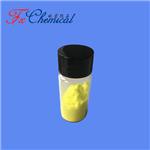Exploring APS-5: A Breakthrough in Material Science
Apr 11,2024
Introduce
In the dynamic realm of material science, APS-5 stands as a beacon of innovation and potential. This novel material, a synthesis of advanced polymer structures, has garnered significant attention for its unique properties and wide range of applications. From energy storage solutions to cutting-edge sensors, APS-5 is at the forefront of driving technological advancements. As we delve deeper into its chemical properties and applications, the significance of APS-5 in shaping the future of materials science becomes increasingly apparent[1].

Fig. 1 Characteristics of APS-5
APS-5's Chemical Properties and Synthesis
At the molecular level, APS-5 is characterized by its robust framework and exceptional stability, setting it apart from traditional materials. The synthesis of APS-5 involves intricate polymerization techniques that result in a material with superior thermal and chemical resilience. What makes APS-5 particularly intriguing is its tunable porosity, allowing scientists to customize its structure for specific applications, a feature that is not commonly found in similar materials.
Compared to its counterparts, APS-5 boasts a higher efficiency in catalysis processes, thanks to its increased surface area and enhanced molecular interaction capabilities. These attributes not only contribute to its effectiveness but also its sustainability, offering a greener alternative for various chemical processes.
Applications of APS-5 in Material Science
The versatility of APS-5 is one of its most compelling attributes, finding utility across a myriad of sectors. In energy storage, APS-5's enhanced electrical conductivity and stability make it an ideal candidate for developing next-generation batteries and supercapacitors. This could revolutionize how energy is stored, paving the way for more efficient and durable power sources.
Furthermore, APS-5's sensitivity to environmental changes positions it as a promising material for sensor technology. Its application in detecting pollutants and hazardous substances could lead to significant advancements in environmental monitoring, contributing to a safer and healthier planet.
In catalysis, APS-5's unique surface properties and chemical stability facilitate more efficient and selective reactions. This efficiency is particularly beneficial in pharmaceuticals, where APS-5 can be used to streamline drug synthesis, potentially reducing costs and improving outcomes in medicine development.
Innovation and Challenges
The introduction of APS-5 represents a significant leap forward in material science. Its unique properties and potential applications herald a new era of innovation, where materials are not only evaluated based on their strength or durability but also on their environmental impact and efficiency.
However, the path to fully realizing APS-5's potential is not without challenges. The complexity of its synthesis process poses significant hurdles in terms of scalability and cost-effectiveness. Furthermore, the sustainability of raw materials required for APS-5 production remains a concern that needs addressing to ensure its applications are truly green and sustainable.
The Future of APS-5
Looking ahead, the potential applications of APS-5 are boundless. Its adaptability to various needs and sectors hints at a future where material science could offer tailored solutions to some of the world's most pressing challenges. From cleaner energy sources to more effective medical treatments, APS-5 could play a pivotal role in the next wave of scientific and technological breakthroughs.
However, achieving these prospects requires ongoing research and collaboration among scientists, engineers, and industry professionals. The exploration of APS-5 is just beginning, and its journey from the laboratory to real-world applications promises to be as exciting as it is challenging.
Conclusion
APS-5 emerges as a material not just of interest but of importance in the realm of material science. Its unique properties and the promise it holds for future applications underscore the significance of continued research and development in this field. As we stand on the brink of discoveries and innovations, APS-5 invites the scientific community to explore the uncharted territories of material science, promising solutions to global challenges and opening doors to new possibilities[2].
References
[1]No C G H S. Power source Battery Pack APS 5[J]. Signal, 2008, 1272: 2.2.
[2]Tiwari O. Identifying code smells in source code and automatic removal of Long Method code smell using Structure Dependence Graph (SDG)(APS-5)[J]. 2019.
- Related articles
- Related Qustion
- APS-5: Synthesis and Application Dec 9, 2022
APS-5 is mainly used as the core reagent of chemiluminescence substrates.
ACP-105, a SARM, enhances strength, muscle growth, and fat loss with minimal adverse effects. Dosage ranges 5-15 mg daily, offering versatility in cutting and bulking cycles.....
Apr 11,2024APISalicylaldoxime, derived from salicylaldehyde and hydroxylamine, is vital in chemistry, medicine, and metallurgy, facilitating metal complexation and extraction processes.....
Apr 11,2024APIAPS-5
193884-53-6You may like
- Lumigen APS 5
-

- $188.00 / 1KG
- 2024-01-06
- CAS:193884-53-6
- Min. Order: 1KG
- Purity: 99%, 99.5% Sublimated
- Supply Ability: g-kg-tons, free sample is available
- APS-5
-

- $0.00 / 1G
- 2023-02-21
- CAS:193884-53-6
- Min. Order: 1G
- Purity: 98%min
- Supply Ability: 30kg/month
- 9-(4-Chlorophenylthiophosphoryloxymethylidene)-10-methylacridan,disodium salt; APS-5
-

- $0.00 / 1kg
- 2022-09-28
- CAS:193884-53-6
- Min. Order: 1kg
- Purity: 98%
- Supply Ability: 1Ton




